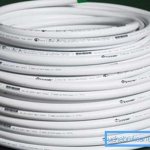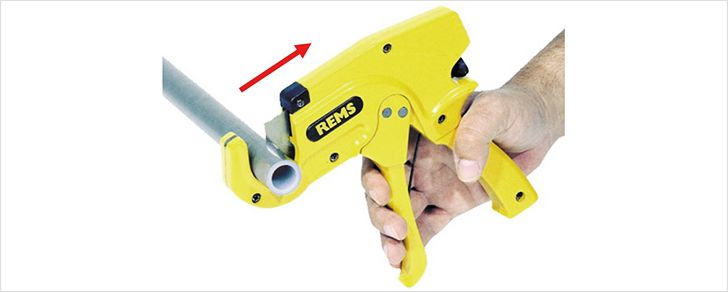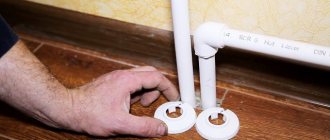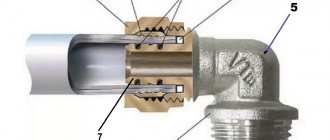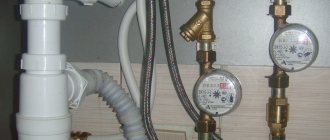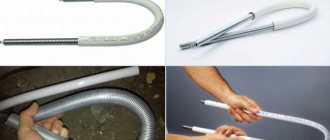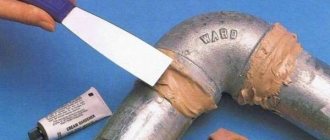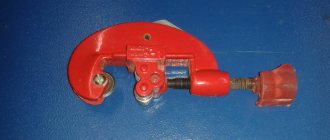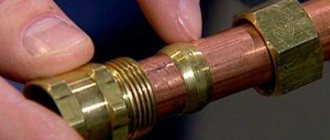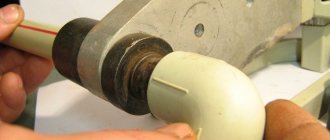Reinforced-plastic pipes are capturing an ever larger segment of the plumbing market, so the issue of their maintenance is becoming more urgent. It is believed that if it is necessary to replace such pipes, the entire pipeline must be changed. But this opinion is wrong.
Products are easy to cut and change in parts without harm to the general water supply or heating system. Below is how to properly cut metal-plastic pipes.
Cutting methods
There are several basic cutting methods, which directly depend on the tool used. First of all, you can cut products:
- Knife for efficient cutting of reinforced plastic pipes. The knife in this case should be used self-sharpening.
- A hacksaw for metal. The simplest method, which, however, will require a lot of effort and time from the performer. In addition, the edges can be torn.
- Scissors.
- Pipe cutter.
With some tools, the cut edges are quite uneven and material particles can subsequently cause blockages. The best way is to use special scissors, which cut straight off without leaving torn edges. These scissors can cut objects up to 40 mm in diameter.
Important! In this case, you will not have to make any special efforts, since the tool is specially designed for such work and has special blades. These blades can easily cut through plastic pipes anywhere.
For products with a larger diameter, it is better to choose a pipe cutter. Pipe cutters are telescopic and ratchet. The first type is based on the work of a special roller that rolls along the entire circumference. The second type is more like a scissor, as it uses a lever system with two handles.
Purpose
When installing metal-plastic pipes, it is impossible to do without making cuts. To perform this operation, you can use:
- Serrated knife or hacksaw for metal. Relevant for performing one-time work. If you need to cut a lot of pipes, this method is not suitable, since a large amount of costs is required, the ends are uneven and have burrs.
- Bulgarian. Metal blades quickly cut multi-layer parts, but the power tool makes a lot of noise, after cutting a large amount of debris remains.
- Pipe cutter. The most relevant way if you need to deal with large-scale pipelines.
How to cut metal-plastic pipes
Reinforced-plastic pipes have a number of advantages over their competitors. They are much lighter than metal and much more resistant to oxidation than copper. They are easy to replace and easy to shape.
You can create piping of any shape. Well, the main advantage is cost. It is much lower than that of copper pipes. And the quality is at about the same level.
During operation, it may be necessary to cut pipes. For this, a special tool is used that is designed to work with such a material.
To improve the effectiveness of the procedure, it is recommended to properly prepare the pipe and tools before work. Let's consider the main features of metal-plastic pipes and how to cut them.
Preparing the pipe and the necessary tools
The cutting device itself, measuring tapes, adjustable wrenches, seals and some other things are used as tools. All this should be in an accessible place at the time of work.
Sometimes it is necessary to strip the outside of the reinforced covering to facilitate the cutting process in the next step. For stripping, a clutch with blades is used, which allows you to get a perfectly smooth cut and get rid of the polymer layer. This is necessary for welding work, which is likely to be carried out during the installation of the pipeline.
Important! When working, it is necessary to cut off exactly as much material as is needed for the fitting of a fitting for metal-plastic products.
Little about assembly technology
Regardless of whether the installation of a water supply system or a heating system is being carried out, the assembly of metal-plastic pipes is carried out in the following sequence:
- pipeline cut. The pipeline is supplied in bays, so this is indispensable. At this stage, it is necessary to control the level of cut quality especially whisperingly, there should be no burrs at the end,
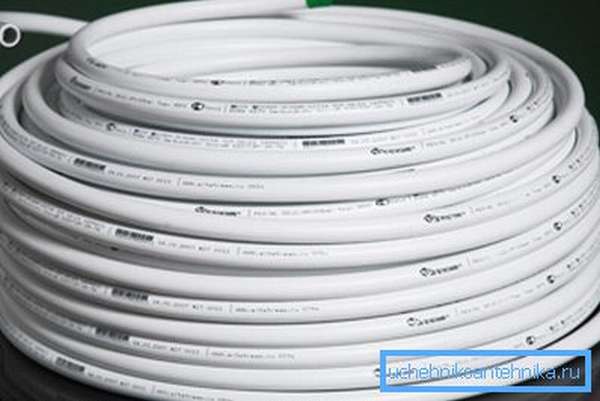
- calibration - at the end of the work with scissors, it is imperative to return the section geometry, it is possible to combine this operation with chamfering,
- in fact, the connection will fit any of the common fittings, for example, American.
The better to cut a metal-plastic pipe
At a time when the question arises of how to cut metal-plastic pipes, special scissors can be considered a good option. Their blades allow you to take the perfect level of cut quality, without burrs and wrinkles.


Note! If on the handles of scissors, then the material may flatten a little. To prevent this from happening, the pipe must be rotated during cutting.
If there are no scissors at hand, then it is possible to do with a simple hacksaw. Indeed, in this case, the level of cut quality will be slightly worse.
At the end of the hacksaw, you will need to file the edges with a file. A non-specialized requirement for both options is the perpendicularity of the cut plane to the longitudinal axis of the pipeline. In addition, a small skew may become a circumstance for depressurization of the joint in the future.
Calibration of the pipeline
The calibrator is the most important tool for multilayer pipes, which allows you to return the shape of the section. Often, when cutting a pipeline, its end is slightly deformed, and the calibration operation will allow it to become round.
It is possible to distinguish 2 types of calibrators:
- a tool that is recommended only for geometry restoration and flaring work,


- a calibrator for metal-plastic pipes, which, in addition to these operations, allows you to immediately remove a chamfer.
As for the calibration technology, it is performed in the following sequence:
- a suitable nozzle diameter is selected and inserted into the pipeline. If the end is deformed, then an effort may be useful for this,
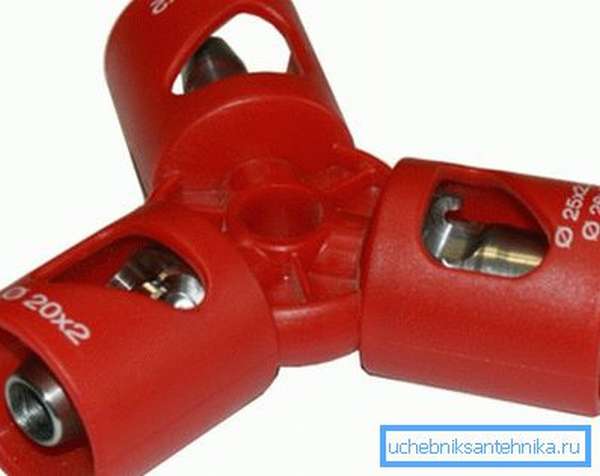

- then a calibrator is needed, without removing the end of the pipeline from it, the blades of the knives will chamfer at the desired angle.
Pipeline installation
At a time when a person thinks about how to work with reinforced-plastic pipes, most of the questions arise regarding the choice of a connection.
There are many ways, any of them has its own advantages:
- push fittings... Along with this, the end of the pipeline to the stop; for convenience, they also have a viewing window. The disadvantage for the type of connection is a high price, and the joint itself turns out to be one-piece,
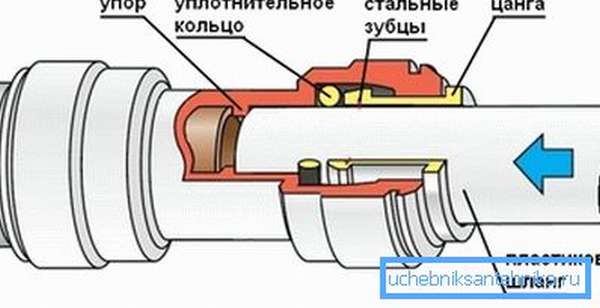

- press fittings... This method of joining is used when it is necessary to connect metal-plastic to metal. In addition to the fitting itself, press tongs are also useful. The tightness of the joint is achieved due to the deformation of the metal.This type of joint is also considered one-piece,
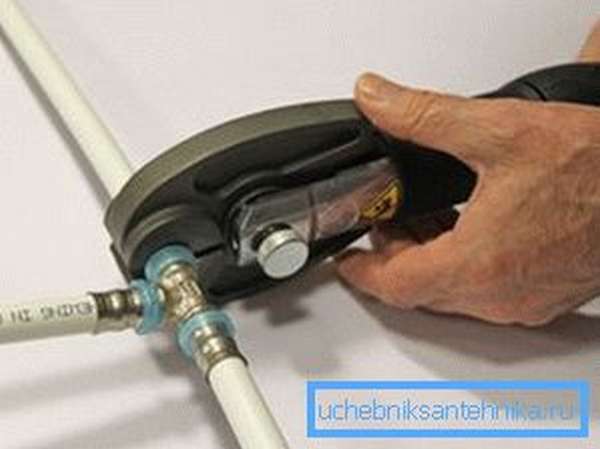

- crimp fittings - the most common type of pipeline connection.
Push-in fitting is one of the most popular types of compression fittings, it provides both greater strength and sufficient tightness of the connection, and if necessary, the joint can be easily disassembled. In addition, such a fitting can be reused.
The device for making connections is as follows:
- a union nut and a compression ring are put on the pipe (compression rings are also known as collets for metal-plastic pipes),
- after that it is inserted into the fitting,
- the nut tightens well, the collet is easily deformed and fixes the end of the pipeline well.
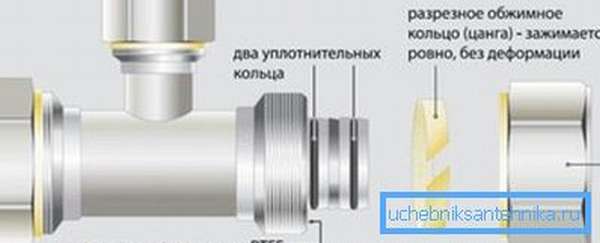

When compared with other methods, it is precisely detachable connections that are more popular. When using them, the question of how to disassemble metal-plastic pipes is easily solved.
Note! When inserting the pipe into the fitting, do not apply too much force, this can damage the rubber seals. To facilitate the process, the end of the pipeline can be lubricated.
Separately, it is worth mentioning the connection by means of Eurocones. The design allows it to be classified as detachable, small differences lie only in the fitting device. A nut and a collet are put on the pipeline, after which a eurocone for metal-plastic pipes is inserted into it, and the nut is tightened.
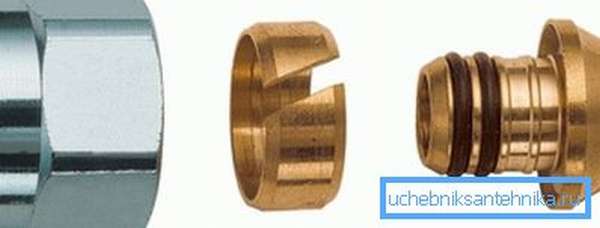

In addition, during installation, such fittings as tees, crosses, adapters that allow connecting different diameters, collectors (for heating systems), corner fittings are useful.
Tools for cutting metal-plastic pipes
In the process of cutting pipes, the following tools come in handy:
It is important for the master to determine in advance what he will use to cut metal-plastic pipes. The most important tool on the list is the scissors. Everything else is necessary for carrying out special preparatory work.
The cutting process does not require much effort. It is enough just to fully control every movement. If you don't pay enough attention to control, you can easily cut off the excess part.
If during the cutting process it is necessary to bend the product, it is not recommended to do it by hand. This can easily ruin the aluminum layer inside. It is better to take a professional pipe bender and perform the operation with it.
Using inappropriate tools in a single area can affect the entire network, resulting in high repair costs.
Important! Special scissors are usually found in the welding kit. But they can be purchased separately. The price of this tool is not high enough to save money on it.
Before proceeding directly to cutting, it is necessary to very clearly measure out the part where the unit will be divided. For this, a tape measure or ruler is used, as well as a bright marker. A faded pencil can simply not be seen, especially if there is not enough lighting in the room. The mark can be made with a knife, leaving a scratch.
During operation, pieces of plastic and aluminum can fly in different directions. Therefore, it is necessary to use protective equipment in the form of glasses and special clothing.
Methods for joining metal-plastic pipes
There are two ways to connect pipes made of metal-plastic:
- using press fittings;
- using compression fittings.
The first method, in turn, can be divided into two subtypes:
- using push-in press fittings;
- by means of crimp couplings.
Installation of a metal-plastic pipeline using compression fittings
The installation of the pipeline can be carried out both according to the collector and tee scheme. When using the latter, fittings can be connected to the pipes in series or cut after laying the pipeline.
Connection diagram of a pipe with a fitting.
Instructions for making a pipeline connection using compression fittings:
- Align the pipe, ensuring a straight, even cut before and after the cut of at least 10 cm.
- The pipe is then prepared as described above. It is also necessary to provide a lead-in chamfer at the ends of no more than 1 mm.
- A union nut is put on the pipe, and after it a split ring.
- A pipe is placed on a moistened fitting in such a way that its end abuts against the edge of the fitting with its entire plane.
- Screw the union nut onto the union by hand until it stops. The nut should follow the thread easily
- The body of the fitting is held with one wrench, and with the other wrench, the union nut is pulled out by 1-2.5 turns so that 1 or 2 threaded threads remain visible.
Cutting technique
Self-cutting can be carried out with products with a diameter of 5 to 30 cm. So if the product does not fall within these limits, it is best to turn to professionals.
When carrying out any such manipulations, it is important to remember the basic rules:
- Reinforced plastic products are very sensitive to temperature, so some problems may arise in hot or cold weather. The material shrinks and expands easily, making it difficult to determine the true dimensions.
- Metal-plastic, like polypropylene pipes, can be cut by any means at hand. But in order to avoid various negative consequences, it is best to do this with special tools.
- A special self-sharpening knife is an excellent tool. But if it is planned to carry out work to replace one section with another, it is better to abandon the tool in favor of scissors.
- The material is quite fragile. Applying too much force is fraught with cracks or specific deformations. The permissible load can be seen in the product passport, which was issued at the time of installation of the water supply system.
- The type of cutting directly depends on the proportion of metal and plastic in the product. If there is more metal, then there should be as little friction as possible when cutting. Otherwise, a large proportion of plastic implies a high intensity of work with high friction.
- Before starting work, be sure to make sure that there is no water or gas flowing through the pipe. You need to turn off all the taps and wait a little.
- After completing the work, you need to properly clean the inside of debris that can lead to blockages or break specialized equipment.
The use of electronic cutting tools is not considered reasonable as the material is not designed for this. You can do it by hand.
Source: znatoktepla.ru
Preparatory stage
The preparatory stage involves cleaning the tubes from irregularities. For this, it is more convenient to use a coupling. After that, you can start cutting the metal-plastic pipe.
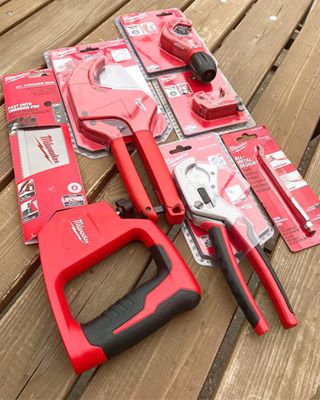

Tool (Photo: Instagram / redtool.pro)
Cutting technique
Do not use tools that are not intended for cutting metal-plastic. They can damage the material, leave irregularities, burrs. Also, do not try to bend the tube with your hands. To do this, you need to use a pipe bender.
Do not use too much force when cutting. It is important to control the process so as not to damage the part. Marks for future cuts can be made with a pencil or marker. Do not use sharp objects for this.
Technical features
On your own, without specific skills, you can cut pipes up to 30 cm in diameter. If the dimensions are larger, you need to seek help from experienced installers. It is not recommended to cut parts in hot weather in direct sunlight. The material heats up and the cut mark moves to the side.
It is important to read the technical data sheet of the details in advance if it was issued upon purchase. If it contains more plastic than metal, work must be done quickly.If there is more metal, you need to choose the tool that will have the least friction. After cutting, the tube must be wiped with a damp cloth to remove dust and debris.
If you do not have a pipe cutter at hand, you can use a knife with a serrated sharpening. It is necessary to lubricate the blade with machine oil in advance, check its sharpness.
Due to the improved technical characteristics, reinforced-plastic pipes are very popular. To cut them, you can use a grinder, a hacksaw for metal, a sharp knife or a pipe cutter. The latter option is preferable, since the cuts will be smooth, without burrs. In addition to this, you do not need to expend too much effort.
https://youtu.be/aj7PksBLcwU
Briefly about the drainage system
The sewerage device is a description of all the components and the principle of operation of the system as a whole and for individual nodes. Subdivided into:
- Internal - located in the building.
- Outside - is laid outside the buildings.
Internal
Internal sewerage device:
- Plumbing fixtures (sources of dirty water formation): toilet bowl, bidet, washbasin (kitchen sink), bathtub (shower cabin), washing machine and dishwasher.
- Siphons and connection elements (transition couplings).
- Outlet pipes Ø 30-50mm. For toilet bowl 100mm.
- Transitional elements: fittings and couplings, check valve, revision.
- The main riser is an element that collects wastewater from all sources into one sewer pipe. The collector diameter should not be less than 100mm.
Installation of the sewerage system inside the premises is regulated by regulatory documents: SNiP (Sanitary Norms and Rules) 3.05.01–85 "Internal sanitary-technical systems".
Outdoor
The external system includes:
- Waste line from pipes Ø 100-200mm (for individual housing).
- Overflow (inspection) wells.
- Couplings, fittings.
- Wastewater receiver (cesspool, septic tank, biological treatment station).
Installation of sewerage outside the building is regulated by SNiP 2.04.03–85 “Sewerage. External networks and facilities ".
Installation
The installation of an internal sewerage system and an external highway is in many ways similar. The difference is in the materials used. For internal sewerage systems, gray-colored collectors are used. The outer ones have an orange tint. This is due to the difference in external loads:
- Indoor products are affected by their own weight and, periodically, by the load from the flowing liquid. Thermal heating up to 60–90 ° C is added with a parallel chemical attack from the waste components.
- Parts located outside the building are exposed to:
- pressure from the mass of the covering soil;
- the effect of the weight of passing vehicles;
- experience efforts from buildings located on top;
- exposed to external temperature extremes, from negative to positive.
Hence, the installation of the internal sewerage system is carried out with a predominance of polymer materials:
- PVC (polyvinyl chloride). More precisely, unplasticized PVC (PVC – U).
- HDPE (low pressure polyethylene).
- PPR (polypropylene).
The most in demand are PVC products. Installation of internal collectors is carried out by joining the narrowed part of the pipe and the expanded one (socket). Additional elements are used, - fittings (transition couplings, tees, elbows with an angle of 45 ° and 90 °, bends).
Installation of sewer pipes is carried out with the obligatory observance of the angles of inclination:
- For collector Ø 50mm, the slope will be 2–3 cm per one running meter of length.
- For a product Ø 100mm, about 1–2 cm per 1 meter.
In the process of installation or repair work, there is a need to saw the plastic part. Polymers do not have high hardness and strength compared to metal products. Therefore, they are processed by most locksmith and mechanical tools. It is possible to cut a plastic pipe by:
- hacksaws for metal or with a small hardened tooth;
- triangular file;
- jigsaw (for diameters not exceeding 50mm);
- circular or reciprocating saw;
- grinder and other tools.
Installation of sewerage systems is carried out according to the rules based on the requirements of SP 30.13330.2012. In addition to observing the slopes, it is necessary to correctly distribute the points of attachments and connections. If technically possible, it is recommended to carry out hidden wiring.
Installation of sewer pipes indoors begins:
- with drawing up a work plan;
- performing a sketch or drawing;
- determining the required dimensions of the collector;
- preparation of the necessary material;
- preparation of a tool with which you can cut a plastic part.
At the end of the stage of installation work, the internal sewerage device is checked visually. Further, it is necessary to spill the system with water in order to identify possible product defects or the presence of leaks.
Outdoor system installation
Installation of sewage from plastic pipes outside the building is carried out, in most cases, inside an earthen trench. This is due to:
- the need to protect the plastic sewer structure from the effects of negative temperatures;
- rational use of the surface of the earthen plot; protection from possible mechanical damage.
Installation of sewerage systems outside the trench is carried out:
- in the presence of a high level of groundwater (wetland);
- rocky or frozen ground (permafrost);
- other technical restrictions.
Installation of sewer pipes on the site is carried out mainly in the warm season. This makes it easier to install sewer pipes - a more comfortable climate and the presence of thawed earth.
Outdoor products - red pipes, made of polymers. You can cut or trim parts in the same way as for indoor structures. Installation of sewer plastic pipes is carried out on its own or with the involvement of a third-party organization.
The way - how to cut the parts, when the installation of sewer pipes takes place indoors or outside the building, it is advisable to think over in advance, before starting work. Otherwise, the necessary device or tool may not be at hand, which will significantly complicate the process of installing the line.
Source: hemkor.ru
Top models on the instrument market
In the toolbox in the garage of a home craftsman, the most common pipe cutter-scissors for metal-plastic pipes. In order not to rack your brains, understanding all the variety of tools in construction departments, it is better to immediately familiarize yourself with the rating of popular high-quality models of different price categories and make a choice based on the experience of other buyers.
Budget models for home use
Sturm is an inexpensive and practical option for home use. The device is equipped with a hardened steel blade. The metal parts are coated with a corrosion protection agent. The handle is made of comfortable plastic with a non-slip surface. The cost of a pipe cutter from Sturm ranges from 400-450 rubles.
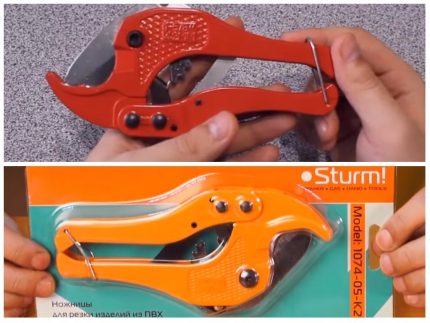

Cheap does not mean poor quality. Yes, budget models of pipe cutters do not have all the advantages of professional equipment, but they perform their main function
Another budget pipe cutter is produced by WMT. This tool will cost you no more than 300 rubles. For that kind of money, you don't have to count on additional functionality and other pleasant little things, but the device copes with its work within reasonable limits. It cuts metal-plastic pipes up to 42 mm.
Professional pipe cutting equipment
RIDGIT is one of the market leaders in pipe cutting tools. This manufacturer offers professional equipment that can work in any conditions. RIDGIT PC 1375 ML is one of the most popular models of this brand.
Lightweight (only 320g) steel body and robust cutter cuts the pipe in just a few seconds. A wide range of working diameters (up to 42 mm) allows you to work with the most popular pipe sizes. The cost of RIDGIT PC 1375 ML starts at 3600 rubles.
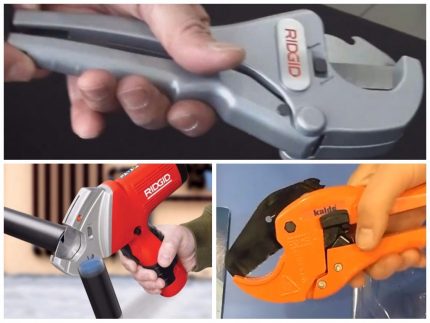

Any experienced builder can tell the difference between a professional tool and an "amateur" one, just by holding it in his hands. And you don't have to know brands for that. If the item is of high quality, it speaks for itself.
Another popular model from RIDGIT is the TC-40. This is an automatic pipe cutter. It is equipped with a 0.75 kW motor and a 12 V lithium battery. The device can easily handle pipes from 3 to 42 mm, just press a button.
There is such a nice addition as a backlight for working in low-light places. Since the multilayer metal-plastic pipe, the manufacturer took care of a special adapter for this type of materials. The price of an automatic tool is from 18,000 rubles.
The professional Milwaukee tool from the USA is a guarantee of high-quality and reliable performance for many years of service. The Milwaukee ProPEX Tubing Cutter is a small diameter pipe cutter up to 25mm. It is made of durable steel that does not corrode. The comfortable handle has a high level of ergonomics. But the price for a high-quality pipe cutter is also appropriate - from 2300 rubles.
The Turkish brand KALDE offers a wide range of metal-plastic pipe shears. For example, KALDE (40-63) is a model for cutting large diameter pipes - from 40 to 63 mm. The blades are very well sharpened, the tool does not bend metal-plastic pipes, does not bite the edges and does not leave chips. All KALDE products are manufactured in accordance with European quality standards. The price for a specific model in stores is about 4300 rubles.
Hacksaw
The first is a hacksaw. Having come with a pipe and a hacksaw to some object, they do this.
Straight edges are obtained. And when the pipe is inserted into the pipe, this rubber band bites from the edge, so the plumbers have to do an additional operation, namely, chamfering. This is done either with a knife, respectively, or the pipe simply rubs against the concrete, and a chamfer is obtained.
Why is this method good? It is a small tool, relatively small. Although we see that we have it quite large and long, and without protection, it cannot be moved. Well, if you want to round off the edges, you need a knife.
Bulgarian
The more financially secured plumbers carry a small grinder with them. I'm not talking about Bosh, I'm talking about some cheaper one. Now I will set it up for myself. And we cut the pipe accordingly.
The method is faster than the first one. It produces smoother edges. Of course, it also depends on where the hands of the person who saws grow from, but the edges are smoother.
There is one drawback compared to the first method - this is a chamfer. A chamfer is obtained with such burrs, and these edges have to be processed additionally. Well it will go. But the grinder is overgrown with such a cobweb, chacha, and it is quite difficult to clean it.
Plastic pipe cutting tool
And there is another modern method of pipe processing - the P-TEC 5000 tool. There is a viewing window. We bring it to the depth marked by us and rotate it in a circle. The result is a perfectly straight cut and bevelled edges.
An ideal cut is obtained on two pieces at once, and a chamfer is also obtained on two pieces. Faster, easier. No need to carry a grinder, no need to carry such a hacksaw. Very comfortably. The button is pressed, placed and gone.
More convenient than most existing pipe cutters, but there is a drawback. It is only available for 50, 32 and 40 mm pipes. For the latter two, there is a double-sided apparatus with two holes. Their only drawback is that they are closed, that is, the pipe must be pushed inside.
Source: transkribator.guru
High-quality cutting of polypropylene pipes
Due to the growing popularity and prevalence of polypropylene pipes (propylene polymer) used to equip water supply systems and other communications, the demand for a specialized tool that makes it easier to work with the material has increased significantly.
Particular, exclusive attention is paid to the correct choice of the model of shears that cut polypropylene pipe products. This greatly simplifies the preparation of the entire set of parts for wiring installation.
As a rule, straight lengths (up to 12.0 m) are sold on the market, although polypropylene pipes in coils are often found, which are used for the installation of underfloor heating systems.
The main types of tools cutting propylene pipes
All modifications of equipment manufactured for cutting thermoplastic polymer propylene pipes are subdivided into several design options.
1. Precision scissors - have a fairly simple, reliable split-tappet mechanism. This tool can dissect and fragment products with a diameter of 3.0–41.5 mm. The cutting tool has a steel blade (alloy grade) with a serrated bar, allowing for fairly easy, even cuts in propylene pipes.
Using precision scissors, you can easily cope with one hand, however, with large volumes of fragmentation of the material, fatigue of the muscles of the hand, forearm and shoulder quickly increases. Buying a tool implies a one-year warranty, valid only with the correct use of scissors.
2. The cordless pipe cutter is an automatic tool for ultra-fast (maximum 7.0 seconds), accurate cutting of medium-thickness propylene pipes (8.0–29.5 cm). The compressive force of the cutting surfaces is provided by a small, powerful electric motor.
3. Roller pipe cutter is an easy-to-use modification of the polypropylene cutting tool. Despite the simplicity of its design, the employee can make an absolutely even cut. In this case, the pipe elements are cut at an even (90 degrees) angle.
Attention! Any deviation in the process of cutting from an even, right angle (90 degrees) can provoke a breakdown of the tool or deformation damage to the lines of the cut!
Roller pipe cutters are available with telescopic extensions. These instruments are equipped with a ratchet device and generally resemble conventional scissors. This pipe cutter has, on the one hand, a C-shaped recess where the pipe to be cut is placed. The opposite side contains a sharpened cutting blade. After closing the handles with a brush, it cuts off the pipe in an even plane.
4. Guillotine pipe cutter is a device used for cutting large diametrical pipes (63.5-350.0 mm). The tool is characterized by the presence in the design of a high-strength, sharp-edged blade covered with Teflon. Smooth installation of the pipe, as well as slow cutting with very sharp blades, contribute to the maximum smoothness of the end surfaces. This greatly facilitates subsequent electrofusion welding without additional processing of the pipe ends.
Recommendation! When a specialized tool for cutting polypropylene pipes is not available, you can use a special hacksaw for metal or wood. It must be remembered that the slightest violation of this technology can spoil the cut pipe. In addition, the end plane of the cut must be additionally cleaned from burrs and forming chips, and this takes a lot of effort and extra time!
Press fitting
The connection of pipes using the press fitting method allows you to brick the pipes into walls or fill them with concrete without fear of leaks. This method is more reliable than compression fitting. However, you will need specialized tools and equipment.
To install pipes you will need:
- Crimp couplings;
- Hacksaw for metal or pipe knife;
- Calibrator for processing edges;
- Crimp tongs (electric or manual).
Thanks to the use of pressing tongs, the connection of pipes is obtained of high quality. There is no need to buy fittings, which means that installation costs are reduced.
Step-by-step instructions for installing pipes using the pressfitting method:
- We make the necessary calculations, measurements and cut off a piece of pipe of the required length.
- We process the end of the pipe with a calibrator, returning it to its original shape.
- We put a crimp sleeve on the pipe.
- Insert the fitting equipped with a rubber seal.
- We squeeze the clutch with press pliers, as a result of which a ring will appear on the clutch. Remember that you can only crimp the coupling once, and if you do something wrong, the part will have to be replaced with a new one.
If you purchased a fitting with a coupling already attached to it, then the connection process will look slightly different.
The first step will also be to measure and trim the pipe and trim its edges. Then it will be necessary to fit the pipe onto the fitting. It will be possible to control and adjust the tightness of the fit through special holes in the crimp sleeve.
The pressfitting connection can be used for plumbing, heating and underfloor heating systems.


Crimp pliers
Some people don't use the pressfitting method just because they need to purchase a press jaw. But it should be borne in mind that recently, many stores have been practicing renting this tool out, which allows you to save on the purchase and install metal-plastic pipes at no special cost.
The choice of a specific type of polypropylene pipes for certain conditions
To cut pipes made of polypropylene material, scissors are selected for a specific value of their diametric size. Manufacturers today present pipe material in four versions:
- РN-10 - is chosen to create a "warm floor" system and cold water supply. The coolant should not be hotter than +45.0 C, and the in-line pressure should be maintained at 1.0 MPa;
- PN-16 - suitable for the distribution of chilled water, as well as for the piping of the centralized heating system. The coolant is supplied under low pressure - no more than 1.7 MPa;
- PN-20 is a universal version of the pipe, which is actively used for the installation of hot, warm or cold water supply. Mandatory conditions for installing PN-20 pipes: the maximum internal pressure is 2.1 MPa, and the temperature of the coolant is not more than +80 C;
- PN-25 is a pipe material reinforced with aluminum foil. This solution allows the pipe walls to withstand an internal pressure of 2.6 MPa and a maximum water temperature of +95 C. This type of pipe is perfect for installing central heating and hot water supply.
Important! The choice of the type of polypropylene pipes should be carried out carefully, with scrupulous consideration of the temperature and pressure of the water in the system, since the immediate service life of the pipeline depends on these factors!
In addition to various polypropylene tubular products, manufacturers produce many fittings and combined elements. The latter are often equipped with molded brass inserts with internal or external threads.
Metal inserts allow easy seals and material conversions.
Remember! Only professional, high-quality modifications of cutting tools can effectively cope with cutting polypropylene pipes, regardless of their wall thickness and diameter!
Types of tools for the installation of metal-plastic pipes
The following tools are used to connect metal-plastic pipes:
- Pipe cutter or scissors for cutting metal-plastic.
- Angle grinder (grinder).
- Pipe bender.
- Building hair dryer.
- Manual press, or press tongs.
The grinder and the building hair dryer are driven by an electric motor. Household pipe benders for metal-plastic pipes are usually hand-operated. The hand crimp press has several varieties with different types of drives.
Mechanical
Hand or mechanical mini pliers are used for crimping water pipes up to 20 mm in diameter. These are used for internal distribution of hot and cold water. These tools do not have an electric drive or hydraulic boosters; they use human muscle power to operate them.
Manual drive
Manual pipe benders, self-made Volnov machines have a more complex design than simple tools. The force required to bend is quite significant and levers are used to operate such structures.


To crimp metal-plastic heating pipes (25 mm, sometimes 32 mm), a standard manual press is used to crimp press fittings. To enhance the muscular strength of a person, a gear transmission is used, it also helps to correctly adjust the crimping force.
Hydraulic
For crimping pipelines of larger diameter (up to 32 mm), hydraulic pliers are produced. A reinforcing hydraulic cylinder is built into one of the pliers handles. When the handles are squeezed in the hydraulic cylinder, the pressure rises, the force is transmitted to the crimp head of the pliers. Such pincers are quite expensive (from 10,000 rubles), they require qualified maintenance.
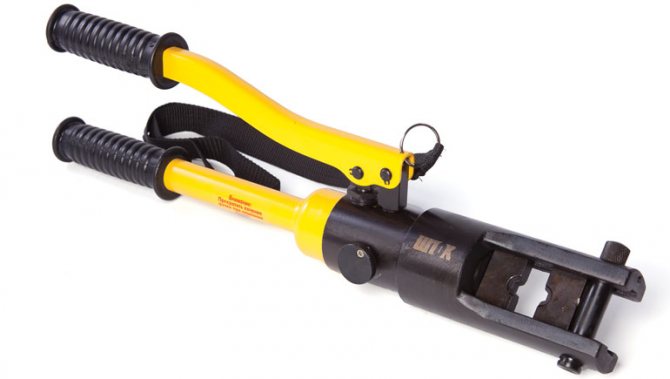

Electro-hydraulic option
All previous models are used in the installation of metal-plastic engineering systems in small volumes. In industrial construction or if you are constantly installing plumbing systems, it makes sense to purchase a powerful electro-hydraulic pressing tool. Such equipment is used for the installation of pipelines with a diameter of up to 108 mm.
The electro-hydraulic press tool has high performance and the highest quality and tight compression. The devices are equipped with nozzles for crimping pipes of different diameters. Electric pliers for common household diameters up to 50 mm can be operated with batteries.
How to cut polypropylene pipes? Principles for choosing a good tool
First of all, when choosing a quality tool for cutting propylene pipes, it is necessary to build on the planned intensity of its subsequent use. When you need one or two cuts, precision or roller shears are fine.
If you have to cut pipes often, then the battery model would be the best option. Of course, the guillotine pipe cutter will effectively cope with the work, especially when cutting pipes with large diameters.
Feature! An important drawback is characteristic of all modifications of pipe cutters - the blade may move a little to the side during cutting. This is not critical for small diameters, but large-size polypropylene pipes must be eliminated from such a flaw. Therefore, cut large pipes with a guillotine cutter!
Advantages of manual and electric pipe cutters
The tool for cutting metal-plastic pipes can be of 2 types:
- manual;
- electric.
A hand pipe cutter works by counting the muscular strength of the person who uses it. It can be used in any conditions, there is no connection to the availability of power supply, there are no restrictions on operating time depending on the capacity of the battery and other inconveniences associated with using a power tool.
However, no one will argue that with large volumes of work, hand tools may not be enough. This is especially true for thick-walled large-diameter metal-plastic pipes. Of course, in construction at the household level, such materials are rare, but for a professional plumber, this is a very real situation.
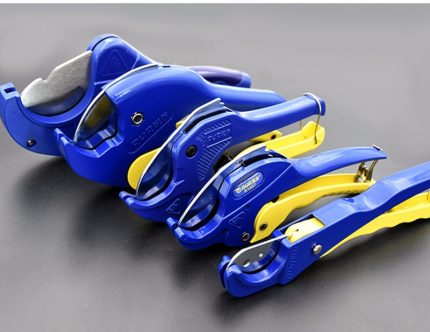

The tool saves the time and effort of the employee.In addition, the human factor is excluded, when "did not hit", "did not check" or the eye failed
The battery-powered electric pipe cutter is a real rescue in industrial-scale cutting. In the case of a power tool, a person only puts a mark where the cut should be made, then fixes the part so that the mark on the pipe and in the pipe cutter window coincides as accurately as possible, then turns on the power and gets a neat, perfectly even cut.
Of course, it's not just convenience. The cost of a cordless pipe cutter for metal-plastic pipes exceeds the cost of a hand tool at times. No one wants to overpay, unless, of course, you will use the device in professional activities almost every day.
Cutting technology for plastic pipes with precision scissors
There are no special rules for cutting propylene pipes. Cutting tools, especially precision scissors, have special recesses in which the cut material is located strictly perpendicular to the sharpened blade.
Caution! With pressure on the handles, the even position of the pipe may be disturbed. This should be prevented in every possible way, otherwise the cut will turn out to be uneven or the tool will break!
It is very important for welding, fitting and other types of connection, to monitor the severity of the cutting angle - it should be exclusively 90 degrees.
When the tool is inconvenient to hold in the brush due to the large handles, it can be clamped in a vice. You can also do it when cutting pipes with a large diameter, since the forces for normal pressing on the lever may not be enough.
It is clear that a large number of pipes cannot be cut in this way, but if the repair is small, you can completely do without large, expensive cutting tools.
How to bend a reinforced plastic pipe
One of the advantages of metal-plastic is its flexibility, which is why it is possible to do with a minimum number of fittings. For example, instead of installing an elbow fitting, it might just be easy to bend the tubing itself. When manufacturing, in order for an element like a coil from a metal-plastic pipe, besides this, you cannot do without bending.
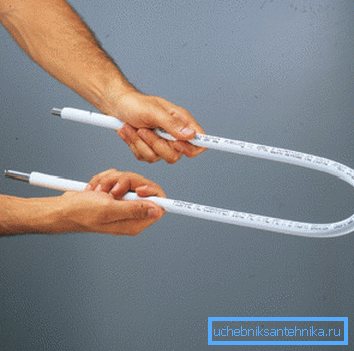

The main problem with pipeline deformation is what it can do. In other words, its walls will converge at the bend, which will make the usual circulation of the coolant impracticable.
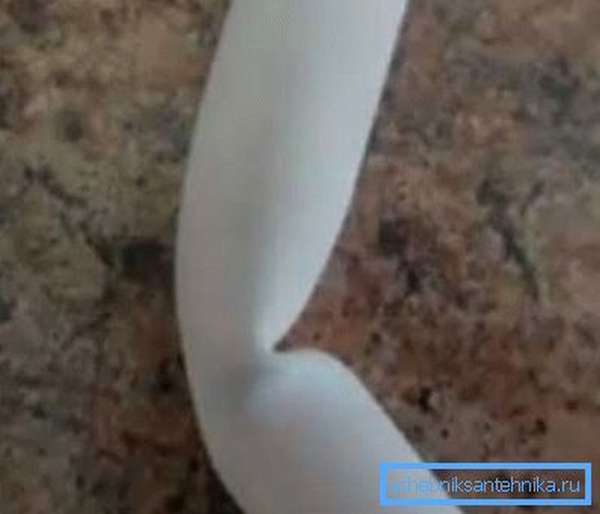

There are two ways to solve this problem:
- by means of a pipe bender,
- bend the pipeline with your own hands. In this case, it will be necessary to fill the inner space of the pipe to prevent kinking.
By hand bending the pipe can be filled with sand or salt. This can replace the mandrel. After filling and sealing the holes at the ends, it is possible to bend the pipeline normally.
Instead of bulk materials, a spring for metal-plastic pipes is also suitable. Its diameter should only be less than the inner diameter of the pipe itself.


As for pipe benders, it is possible to classify them according to the method of bending:
- mandrel - a rigid element moves into the pipeline,
- segmental - along with this, bending is performed using a set of shoes for different diameters and bending radii.
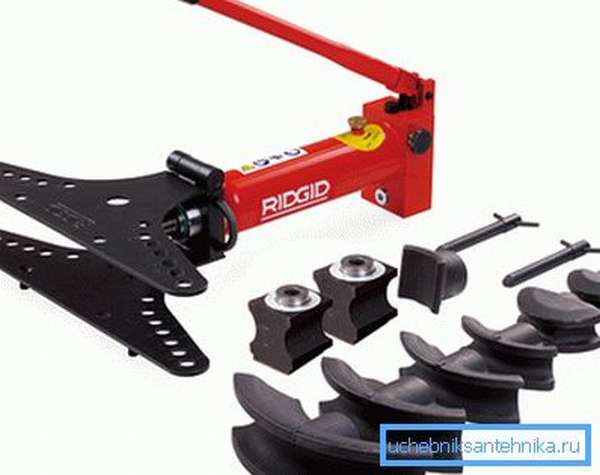

In this case, the instructions for bending the pipe are simple - enough force is applied to the pipe bender lever. The pipe is well pressed against the shoe and deforms.
Note! There is a minimum bend radius for any size. It can be found out by the formula 5 • D, where D is the diameter of the pipeline.
